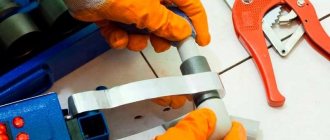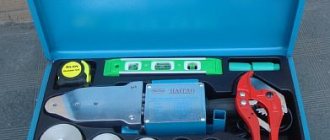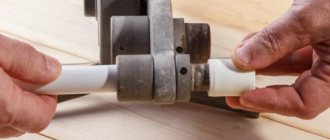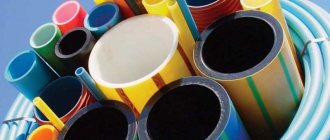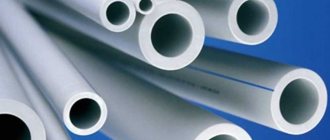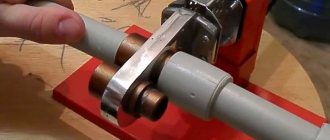One of the stages in the construction of private houses and apartments is the installation of communications responsible for supplying water or draining wastewater. Assembling polypropylene pipes is much simpler than installing metal structures. To connect them, fittings are used, welded using specialized equipment - an iron.
The article we propose describes the technology for making connections and provides the standard temperature for soldering polypropylene pipes. We will cover the preparatory steps required to produce strong and sealed joints. Taking into account our advice, you will assemble the pipeline without any problems.
Soldering of polypropylene pipes
Using PP pipes for heating and plumbing installations
Since the appearance of polypropylene structures on the market, many craftsmen have breathed a sigh of relief. Soldering PP turned out to be an order of magnitude faster and more reliable than metal welding. It became possible to assemble plumbing or heating in one day.
This led to many “masters” starting to do this. Due to ignorance of all the important features of soldering, poor quality connections were often obtained.
In order for the plumbing or heating to last a long time and not cause trouble, it is necessary to follow all technological processes during soldering. Take into account the heating temperature, welding time, and choose the right type of system.
What you need to know about polypropylene pipes
Polypropylene system
Today, manufacturers produce pipes of various diameters, colors, which differ in characteristics. What you should immediately pay attention to when purchasing is the color of the stripes. Pipes with a blue stripe are used for installing the water supply system; those with a red stripe are used for heating and supplying hot water.
You may be interested in the article “How to properly connect an RCD: diagrams, options for connecting to a single-phase and three-phase network” Go>>
A large selection of diameters - from 16 to 110 mm, allows you to assemble various options for water supply and heating systems. For houses and apartments, samples from 20 to 32 mm are used.
When choosing a PP system for installation and soldering, you must rely on the markings specified by the manufacturer.
Marking of polypropylene systems
Below is a table of diameter and thickness depending on the marking.
| Pipe outer diameter, mm | Type of polypropylene pipes | |||||||
| PN - 10 | PN - 16 | PN-20 | PN-25 | |||||
| Passage D, mm | Wall thickness, mm | Passage D, mm | Wall thickness, mm | Passage D, mm | Wall thickness, mm | Passage D, mm | Wall thickness, mm | |
| 16 | — | — | 11,6 | 2,2 | 10,6 | 2,7 | — | — |
| 20 | 16,2 | 1,9 | 14,4 | 2,8 | 13,2 | 3,4 | 13,2 | 3,4 |
| 25 | 20,5 | 2,3 | 18 | 3,5 | 16,6 | 4,2 | 16,6 | 4,2 |
| 32 | 26 | 3 | 23 | 4,4 | 21,2 | 5,4 | 21,2 | 3 |
| 40 | 32,6 | 3,7 | 28,8 | 5,5 | 26,6 | 6,7 | 26,6 | 3,7 |
| 50 | 40,8 | 4,6 | 36,2 | 6,9 | 33,2 | 8,4 | 33,2 | 4,6 |
| 63 | 51,4 | 5,8 | 45,6 | 8,4 | 42 | 10,5 | 42 | 5,8 |
| 75 | 61,2 | 6,9 | 54,2 | 10,3 | 50 | 12,5 | 50 | 6,9 |
| 90 | 73,6 | 8,2 | 65 | 12,3 | 60 | 15 | — | — |
| 110 | 90 | 10 | 79,6 | 15,1 | 73,2 | 18,4 | — | — |
Four types of polypropylene systems are produced:
- PN-10. Used when installing water pipes. Less often for arranging heated floors, with a coolant temperature of no more than 45 degrees. Nominal pressure - 10 Atm.
- PN-16. Can be used for installation of cold and hot water supply. The maximum water temperature is 60 degrees. Nominal pressure - 16 Atm.
- PN-20. Can be used for installation of autonomous heating. The maximum coolant temperature is 90 degrees. Nominal pressure - 20 Atm.
- PN-25. It is used for arranging centralized water supply and heating. The maximum coolant temperature is 95 degrees. Nominal pressure - 25 Atm.
For installation of domestic water supply and heating, it is recommended to use PN-20 grade PP.
PP soldering process
The process of soldering polypropylene systems is not complicated. Welding or soldering occurs between the pipe and various fittings (angle, coupling, tee). Using a special soldering iron, the fitting is heated from the inside and the outside of the pipe.
Soldering process using a special soldering iron
During the heating process, a section of melted plastic is formed. The parts are heated at the same time, and for the same amount of time. Then they are removed from the soldering iron and joined together.
You may be interested in the article “Sewerage for a private house: stages of construction, which septic tank to choose” Go>>
You need to connect the parts quickly, within a few seconds. Otherwise, the polymer hardens and it is impossible to correct anything.
Welding parameters for polyethylene and polypropylene products
Materials Melt Flow Index (MFR)
Welding of high density polyethylene (PE-HD, HDPE)
Products made of high-density polyethylene of melting group with index 005 (MFR 190/5: 0.4-0.7 g/10 min.), group 010 (MFR 190/5: 0.7-1.3 g/10 min. ) or groups 003 (MFR 190/5: 0.3 g/10 min.) and 005 (MFR 190/5: 0.4-0.7 g/10 min.) are suitable for welding with each other. This is confirmed by the standards DVS 2207 part 1 (DVS - German Welding Association) and is confirmed in the documents of the DVGW (German Gas and Water Union).
Welding of polypropylenes: polypropylene homopolymer (PP type 1, PP-N) and polypropylene block copolymer (PP type 2, PP-C, PP-R)
The weldability of polypropylenes is indicated within the melting index group 006 (MFR 190/5: 0.4-0.8 g/10 min.). This is confirmed by DVS 2207 part 11.
Temperature of the welding process of polypropylene and polyethylene
Hot gas welding
| Air, l/min. | Temperature in the nozzle ˚ C | Gas speed cm/min | ||||
| Nozzle diameter, mm | Speed nozzle diameter | |||||
| 3 | 4 | 3 | 4 | |||
| Welding polyethylene | 60-7060-7060-70 | 300-340300-340270-300# | 10-1510-15- | approx. 10 approx. 10- | 50-6050-6025-30 | 40-5040-5020-25 |
| Welding polypropylene | 60-7060-7060-70 | 280-320280-320280-320 | approx. 10 approx. 10 approx. 10 | 50-6050-6050-60 | 40-5040-5040-50 |
Welding with a manual extruder
| Extrudate temperature measured at the nozzle outlet, º C | Air temperature measured at the warm air nozzle, ºC | Air quantity, liters/min. | |
| PE hardPP | 200-230200-240 | 210-240210-250 | 350-400350-400 |
Effect of humidity
Products being welded (sheets, plates) and welding rod made of polyethylene and polypropylene can, under certain conditions, absorb moisture. Studies by a number of manufacturers have found that polyethylene and polypropylene welding rods absorb moisture depending on the material and environment. In extrusion welding, the presence of moisture may appear in the form of pits in the weld or a rough weld surface. This phenomenon intensifies with increasing seam thickness.
In order to prevent such undesirable consequences, the following recommendations have been developed:
- Installation of moisture and oil separators in the air supply system,
- Avoidance of significant temperature differences between parts being welded (condensation moisture),
- Storing the welding rod in a dry place if possible,
- Drying the welding rod at a temperature of 80°C for at least 12 hours,
- Welding wide seams (>18mm) in several passes.
Depending on the type of heating of polypropylene and polyethylene, the following types of welding are distinguished:
- Welding thermoplastics with hot air (hair dryer)
- Welding thermoplastics with an extruder
- Welding thermoplastics using a heating element
- High frequency welding of thermoplastics
- Laser welding of thermoplastics
Soldering table and heating temperature
The quality of soldering depends on the temperature and heating time. It is very important to comply with the required temperature parameters. Both overheating and insufficient heating have a bad effect on the quality of the connection.
- Overheating leads to deformation and reduced permeability.
- Insufficient heat weakens the connection, which can lead to leakage.
Here is a table of temperatures and times for soldering polypropylene pipes:
| Pipe diameter, mm | Heating time, s | Welding time, s | Cooling time, min | Melting depth, mm |
| 16 | 5 | 4 | 3 | 13 |
| 20 | 5 | 4 | 3 | 14 |
| 25 | 7 | 4 | 3 | 15 |
| 32 | 8 | 4 | 4 | 17 |
| 40 | 12 | 6 | 4 | 20 |
| 50 | 18 | 6 | 5 | 23 |
| 63 | 24 | 6 | 6 | 26 |
| 75 | 30 | 8 | 8 | 28 |
| 90 | 40 | 8 | 8 | 33 |
| 110 | 50 | 10 | 10 | 39 |
The soldering temperature of polypropylene systems for all diameters is the same and is approximately 260°C.
The next important temperature parameter for obtaining high-quality soldering is the ambient temperature. It is recommended to make the connection at temperatures between 0° and 25°C.
At air temperatures below 5 °C, it is necessary to increase the heating time by one and a half times.
Another value you need to know when welding is the melting depth. During installation, taking measurements, it is easier to measure the length from fitting to fitting. For example, the distance between two corners is 110 mm, then it is necessary to cut a pipe with a length of 110 mm + 2 * 14 mm, we get a length of 138 mm.
PP melting depth table:
| Pipe diameter, mm | 16 | 20 | 25 | 32 | 40 | 50 | 63 | 75 | 90 | 110 |
| Melting depth, mm | 13 | 14 | 15 | 17 | 20 | 23 | 26 | 28 | 33 | 39 |
Technical characteristics: molecular structure
Based on its molecular structure, polypropylene is divided into several main varieties, including:
- isotactic;
- ataxic;
- syndiotactic.
Stereoisomers of the material differ in physical, mechanical and chemical characteristics. For example, atactic polypropylene has the appearance of a rubber-like material, which is characterized by high fluidity. The melting point of polypropylene for extrusion in this case is approximately 80 °C, while the density can reach 850 kg/m³.
This material dissolves very well in diethyl ether. The properties of isotactic polypropylene differ from those described above and have a high modulus of elasticity, its density reaches 910 kg/m³, while the melting point varies from 165 to 170 °C. In this variety, polypropylene is characterized by excellent resistance to chemicals.
How to choose a high-quality polypropylene pipe
If you decide to install plumbing or heating with polypropylene pipes, then an important step is the right choice. When you know masters, it is better to ask them for advice on what is best to choose and where to buy.
You might be interested in the article “Installing a toilet with your own hands: step-by-step connection instructions” Go>>
Or explore the available product range on the manufacturer’s website. When purchasing in a store, pay attention to the color, company name, logo, and location of the markings. If you find a discrepancy, then it is a fake.
Pipes and fittings have smooth surfaces. There are no swells or depressions. The wall thickness should be the same.
Do not buy fittings and polypropylene pipes from different companies!
Video description
How to solder polypropylene pipes
But in situations where reliability is required, steel clamps with a plastic dowel are used for fastening. There are rubber gaskets on the inside of both halves of the clamp. Clamps of this design secure not only polypropylene, but also polyvinyl chloride and metal pipes.
For the most part, PPR pipes are hidden under plaster, drywall or PVC/MDF panels, but for this they also need to be fixed somehow. Usually, a channel is cut for a water supply, and the pipe itself is secured with a perforated strip suspension to prevent it from falling out. This can also be done without a groove - simply press the PPR tape, like a clamp, pulling it on both sides with plastic dowels with self-tapping screws.
Top best manufacturers of pp systems
Here is a rating of manufacturers of polypropylene systems 2021, compiled according to reviews of specialists. In their opinion, these products are the best in quality and reliability.
Russian trademarks.
The best Russian manufacturers of PP systems
Foreign brands.
The best foreign manufacturers of PP systems
Detailed installation instructions
When soldering PP for plumbing or heating, it is very important to calculate all installation stages in advance. Perform accurate measurements, welding sequence.
The soldering process occurs very quickly, and if a mistake is made, it can only be corrected by dismantling the entire incorrect section.
Let's look at all the stages in more detail.
Preparing special tools
A special tool for welding is a soldering iron or “iron”. If you are at the stage of building a new house, then it makes sense to buy yourself such a tool. It is recommended to choose a manual soldering iron that comes with Teflon-coated nozzles. For home use, a set with nozzles up to 40 mm is sufficient.
Soldering iron for soldering PP
The soldering iron is in a convenient case. The kit for household use includes:
- soldering nozzles PP, diameter from 16 to 40 mm;
- soldering iron stand;
- scissors for cutting PP;
- roulette.
If you are going to use it once, you can ask friends or rent a soldering iron for a while.
You will also need:
- building level;
- hammer drill or impact drill for mounting plastic brackets;
- pencil or marker.
Marking and cutting pipes
Marking and cutting before soldering
Before starting soldering, it is necessary to cut the pipes. To accurately measure lengths, find the distance between the fittings and add soldering depth on both sides. It is convenient to carry out all measurements with an assistant.
There is no need to add length for the coupling.
Carry out the cutting, prepare all the necessary elements and fold the diagram. Mark with a marker the position of the corners and tees in the diagram. When welding, you can accidentally change the position and it will not be possible to connect further according to the diagram.
If this happens, then you need to cut the pipe anywhere and connect them with a coupling. Therefore, when purchasing a pp system, couplings must be purchased with a reserve.
Think in detail about the sequence of soldering elements.
We clean the edges of the parts. They must be evenly cut, clean and dry. When mounting on a wall, brackets of the required diameter are attached in advance. If installation involves placing several parallel pipelines, then it is better to purchase a bracket with a hook to each other.
Mounting bracket
Connecting elements and heating
When everything is prepared, you can start soldering all the elements. Place the soldering iron on a special stand. Attach a nozzle of the required diameter. If several of them are needed, first we attach nozzles of a smaller diameter, then a larger one. Set the temperature to +260 °C and turn it on.
Start soldering strictly according to the diagram and sequence drawn up.
Once the desired temperature is reached, the relay will operate and the power will turn off. There is no need to disconnect it from the network, the temperature will be maintained automatically.
Soldering plastic pipes
To weld two elements, we heat them simultaneously using a soldering iron. We count the time according to the diameter of the elements. After the time has passed, we quickly remove the parts and connect them together. You have a few seconds to correct the position. Therefore, it is very important to note the position of the elements in advance.
Once you have chosen the correct position, fix it for a few seconds, this will be enough so that the knot does not change its position. After cooling, you will get a strong, airtight connection.
You may be interested in the article “Ventilation deflector: 7 popular models” Go>>
We sequentially weld all the components strictly according to the drawn up diagram. We fix the pipes to the wall using brackets.
The nuances of maintaining the desired thermal regime
When designing a piping system, you should strive to ensure that the joints of pipes, fittings and fittings are in accessible places . The overall dimensions of the joint locations should make it possible to install a welding machine and place their ends onto the heater sleeves without significant bending of the pipes.
The closer to the joint the welding equipment can be placed, the less time the heated edge will have time to cool before welding. Such cooling during transportation leads to a significant decrease in the strength and durability of the joint.
It is also necessary to consider the sequence of installation of joints . It is not uncommon for inexperienced designers to find it impossible to install the last joint because the soldering iron simply does not fit into the remaining gap. You have to either strongly bend the pipes, creating residual stresses in them, or cut them and add another joint. Both solutions reduce the overall reliability and longevity of the system.
Experienced shareholders formulated the following recommendations:
- welding equipment must have a high-quality thermostat that ensures accurate setting and stability of maintaining the heating temperature;
- the distance from the welding point to the apparatus should be no more than 1 meter;
- welding should be carried out at room temperature;
- Before connecting, you need to check the temperature equality of both parts.
Following these simple rules will help you solder pipes efficiently.
Errors when performing soldering
We have already talked about some mistakes that inexperienced craftsmen make. Let's remember them and add to this list a few more common errors encountered when soldering.
Soldering errors
- Overheat. Leads to deformation of elements during soldering and reduction of the channel. Nodules form, causing the pipeline to become clogged.
- Insufficient heating leads to a loose connection and leakage. Strictly observe soldering times.
- The soldering process is slow and as a result the soldering is not performed to the required depth. The time intervals indicated in the table must be observed.
- Insufficient force can also affect the depth of adhesion. As a result, the connection will not be tight and will leak. Mark the desired entry length with a marker.
- There is no need to apply too much force either. The depth of the entrance will be too great, which will lead to a narrowing of the canal and poor patency.
- When welding, use those fittings that do not reduce the diameter when soldering. For example, a “sleeve nut” reduces the channel. It is better to use the “American” one, it is more expensive but more effective.
- When soldering plumbing or heating systems, use the same company, do not mix.
- Use polypropylene systems as labeled. You should not save money and install heating using PP for cold water.
- Also, do not save money when purchasing PP systems; choose trusted brand stores that can give you a quality guarantee.
We hope you have found answers to your questions. If not, then leave a comment, we will try to help you.
If you found the article interesting and useful, share it with your friends on social networks.
Basic chemical properties
If you are planning to purchase any polypropylene products, you should know the melting point of this material. It is discussed in the article. From it you can learn other chemical properties. For example, the material is chemically stable, and in organic solvents it swells only slightly. If the temperature rises to 100 °C, the material will dissolve in aromatic hydrocarbons. In this case we are talking about toluene and benzene.
Due to the fact that polypropylene contains tertiary carbon atoms, it is resistant to oxygen under the influence of ultraviolet radiation and elevated temperatures. This makes it prone to aging compared to polyethylene. When exposed to aggressive environments, polypropylene does not crack as much as polyethylene. It is capable of undergoing stress cracking tests even under stress.
